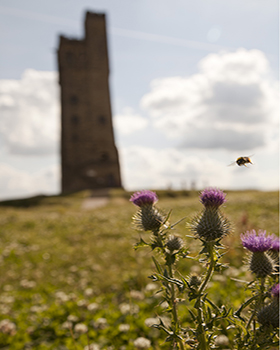Introduction
Our focus

In Kirklees, we know that the environment matters. Without a thriving, healthy environment all the other plans we have for a better future cannot succeed. The environment underpins everything.
It is our home. It gives us the air we breathe, places to relax, resources for our businesses and jobs. It's where nature can thrive.
We want to make sure the environment is a priority. That's why we have made this a top tier strategy alongside the Kirklees Health and Wellbeing Strategy, Inclusive Communities Framework and the 'Inclusive Economy Strategy'; which is currently in development.
Our top tier strategies are interconnected and cover all areas of sustainable development; environmental, economic, and social. Together, they are helping us to deliver a sustainable Kirklees.
We know the environment is not something any one organisation can address alone. That's why this strategy has been co-designed, bringing together council officers, key partners and people who live, work and study in Kirklees.
As a result, this strategy encompasses the environmental work delivered by Kirklees Council and partners and captures new, ambitious ideas for the future. Ideas that will take our action to a new level. We will deliver the strategy in the same way we have produced it - together. Like all of our top tier strategies, this is a partnership.
Our ambition
The ambition of our strategy is encompassed within a vision and four themes which contain 12 headline targets and 31 objectives all underpinned by our three always-on priorities.
Our four themes
Our strategy is structured by the following four core themes:
Always on priorities
Each of the four themes is underpinned by our 'Always-on' priorities. These are the three principles by which we have developed and will deliver the strategy:

Sustainable economic development (SED):
How the Kirklees environment strategy only supports progressive, sustainable opportunities for prosperity and wealth creation across the borough, and actively seeks to counter short term economic growth plans that work against our nature and climate targets.

Resilient futures (RF):
How the Kirklees environment strategy delivers greater ecological, social, and economic resilience for the future, including strong action on climate change adaptation, particularly to protect the most vulnerable people. This theme also ensures that our people are resilient and ready for the future, not least through learning new, transferable green skills.

Environment for all (E4A):
How the Kirklees environment strategy can support fairness, greater inclusion, diversity, and accessibility, particularly for people from ethnic minority backgrounds and those with disabilities. These groups have routinely been given less support on environmental issues and are also proven to be most at risk when it comes to environmental pressures.
Our 12 headline targets
Zero Avoidable Waste by 2038

1. 'Avoidable waste' refers to the things that we throw away that could have been prevented or avoided in the first place. It's the things we discard that still have value or could have been used more efficiently. Examples such as the food we throw away because it's gone bad before we could use or sell it, or designing out avoidable waste in our manufacturing and industrial processes - making them more efficient and less resource intensive.
Growing the sharing economy in Kirklees to be a national leader

2. The 'sharing economy' is about sharing resources like cars, bikes, skills and equipment. It's focused on making more efficient use of these resources, whilst saving money and reducing waste. Examples include passing un-wanted clothing on to other rather than throwing it away, using tool libraries to borrow a drill rather than buy a new one, the use of car clubs, or community spaces that have multiple uses i.e village halls used for exercise classes and makers markets.
Nature in recovery by 2030

3. Nature recovery is the journey our district undertakes to enhance the health of our landscapes, wildlife and habitats by restoring them naturally. These areas have suffered damage or harm from things like pollution, deforestation and climate change. Activities include protecting wildlife and planting forests. Nature recovery is important because it helps protect the environment and keep ecosstems workig properly, ensuring that we have clean air, water and places to enjoy nature.
All degraded peatland to be in restoration by 2038

4. Peatland is one of Kirklees most precious natural habitats and is located in areas such as Marsden Moor and Holme Moss. Unfortuntely, a lot of our peatland has been damaged or deteriorated over time due to human activity or changes to our weather and climate. Restoration is about returning the peatland back to it's original state or condition, so the services it provides our cmmunities can be enhanced, such as helping protect us from flooding, improving local water quality, storing carbon and supporting local biodiversity.
Increase Kirklees tree canopy cover to 21% by 2050

5. Tree canopy cover looks at the amount of ground area in the district covered by branches, leaves and stems from trees as viewed from above. This target is designed to ultimately increase the amount of trees within Kirklees. Tree canopy cover is important as it provides shade and helps regulate local temperatures in hot weather, especially in our towns and villages, it provides homes for birds and other animals whilst also helping to clean the air we breath and absorb Carbon Dioxide.
All people who live work and study in Kirklees to have access to high quality green and blue space within 5-10 minutes / 500m walk by 2038

6. 'Access to green and blue space' simply means having easy ways for everyone in Kirklees to get to natural areas like parks, forest, gardens and bodies of water like lakes, rivers and reservoirs. When we talk about access, we're talking about making sure everyone has the opportunity to enjoy and spend time in these natural areas due to their benefits for our physical and mental health and wellbeing.
Good buildings - all buildings in Kirklees to be energy efficient at a minimum of EPC C by 2030

7. Buildings are where we live, work, socialise and relax. This target is about improving the quality of those buildings to ultimately reduce how much energy they take and money they cost to run. EPC stands for Energy Performance Certificate. These are the nationally recognised way by which we grade the energy efficiency of our homes - they show how much energy the building uses and gives it a rating from A to G, A being the best, G being the worst.
Net zero energy supply by 2038

8. This target focuses on how we can reduce the greenhouse gas emissions we produce when generating heat and electricity, that we use. When we talk about 'net zero' we're aiming to produce as much clean, renewable energy (like solar or wind power) as we consume. We can do this by using energy more efficiently, investing in renewable sources and finding ways to offset any remaining emissions. We ultimately want to find a balance where the energy we use doesn't harm the planet and we're not using more energy than we sustainably produce.
Sustainable neighbourhoods programme launched by 2026

9. Sustainable neighbourhoods is all about making our neigbourhoods healthier, happier, safer and more sustainable for everyone who lives there, now and in the future. The focus is on making it easier to walk or cycle around, improving public transport connections and creating places where people can gather and connect with each other. It's about making sure that the way we live, work and play in our neighbourhoods helps everyone who lives there to have a good quality of life, whilst not impacting our natural environment.
60% of journeys within Kirklees to be sustainable journeys by 2030

10. Sustainable journeys are about finding ways to travel that are good for the planet and our health without compromising on cost of convenience. This involves making choices that reduce our impact on the planet, whilst still getting were we need to go. Examples might be to choose electric cars over diesel and petrol if you can afford to, choosing to cycle, walk or wheel for shorter journeys if you're able, or using public transport like trains and buses where feasible.
100% fleet vehicles to be zero carbon by 2038

11. Applicable to businesses and organisations with a vehicle fleet, this target is about having a fleet of vehicles which don't produce carbon emissions when they are being used. This can be achieved by replacing diesal and petrol cars with electric or other alternative fuels that don't produce harmful emissions. This will help improve the air quality of the areas where these fleets operate, whilst reducing the carbon footprint of the organisation or business.
All of Kirklees homes to be within 1km of a public transport connection point via safe pedestian route by 2038

12. This target is about having easy ways to access public transport connection points like bus stops or train stations. We want to make it more convenient for residents to use public transport to get around. A 'safe pedestrian route' is a path or a way for people to walk or wheel to and from these connection points - making it easier and safe for them to do so.
The 12 headline targets are split across our four themes. Download our targets plan on a page for a printable copy of our targets, priorities and themes. s
We also have our climate emergency targets, which apply to all our themes:
- Net Zero by 2038.
- Climate Ready by 2038.
Our targets for Climate emergency webpage explains how our Climate Change target is for a 'Net Zero and Climate Ready Kirklees by 2038', and what we are doing and have done to work towards this.
How the strategy was shaped
The co-design process outlines the work undertaken to develop the 'Environment Strategy: Everyday, Life' for Kirklees'.

Tailored for Kirklees
- Partners asked for the Environment Strategy to take a 'tailored for Kirklees' approach, rather than follow an existing technical off-the-shelf model, to enable the unique characteristics of Kirklees and its people to stand out.

Designed with, not for
- Involving 1,039 residents and 549 representatives of partner organisations, businesses, institutions and community groups across Kirklees.
- Partners were engaged with on multiple occasions, helping evolve the content over time to delivery a strong, ambitious, and successful strategy for all.

Engage those that haven't yet had their say
- We engaged community groups from across Kirklees who are not commonly involved in the process of helping create a Kirklees-wide strategy. We gave everyone a voice, developed relationships and sought to incorporate a wider variety of perspectives.

It's got to be about everyday, life
- Partners emphasised how the strategy and its targets need to be simple, accessible, relatable, tangible and meaningful.
- The focus needs to be on collective action - making people and organisations feel engaged, included and accountable.
This co- design journey took place between November 2021 and April 2023, categorised by engagement with 'Council colleagues', 'Kirklees Climate Commission' and 'Kirklees Partners'.
Sitting as Kirklees Councils fourth top-tier strategy, the 'Environment Strategy; Everyday, Life' provides a mandate for all council activity to implement its vision and ambitions, so environmentally sustainable practice becomes the business-as-usual (BAU) approach. It has therefore been imperative that Council Colleagues and Elected Members are included within the co-design journey of the strategy, to create buy-in and ownership of what it is aiming to achieve. Steps have been taken on this co-design journey, which excludes the governance decision making process to approve the strategy.
- Executive Team number 1
Presentation of the concept of a top-tier environment strategy and approval to proceed. - Joint Senior Leadership Team
Presentation of the concept to a top-tier strategy and approval to proceed. - Operational Managers Meeting
Presentation of the concept of a top-tier strategy, its scope, purpose and deliverability. - Executive Team number 2
Update on the strategy concept, scope and flightpath with renewed approval to continue. - Kirklees Leadership Team
An outline of what the environment strategy is, the role and responsibilities of Kirklees leaders in co-design and support delivery. - Green Employee Network number 1
An outline of what the environment strategy is, its relationship with the climate work and what GENs role can be in design and delivery. - Tackling Inequalities Programme Board
An outline of what the environment strategy is, its focus on helping address inequality and understanding how it aligns with current and planned work and objectives. - Politician Engagement number 1
A 30 minute session with each political group; Labour, Conservatives, Liberal Democrats, Green and Independents, to outline the strategy and help co-design its vision and objectives. - Green Employee Network number 2
An update on the evolution of the strategy, its vision and objectives alongside an outline of what GEN's role can be in design and delivery. - Politician Engagement number 2
30 minute drop-in sessions for all councillors, per political party, providing an update on the evolution of the strategy since Decembers engagement. Written feedback also offered. - Council Colleague Workshop
A 1 hour 30 minute workshop with service directors, heads of service, employee network representatives and colleagues developing other top-tier strategies to review and co-design the current vision and objectives. - Service area discussion
Follow-on discussions with multiple service areas about the support and guidance required to delivery against the strategy. Attendance at team meetings and calls with heads of service, operational managers and group / team leaders.
The 'Environment Strategy: Everyday, Life' is a partnership at its core. Embarking on a clearly communicated co-design journey with partner organisations, businesses, institutions, agencies and residents is essential to the success of the strategy. Steps have been taken on this journey, demonstrating the sessions dedicated to the Kirklees Climate Commission and those which involved all other partners.
-
Kirklees Climate Commission: Initial Scoping Session
An introduction and initial discussion around the Environment Strategy, its scope and ultimate objectives. -
Kirklees Climate Commission: Conceptual Framework Feedback
A discussion was held around the underlying conceptual framework for the strategy - agreeing to take a bespoke approach, over doughnut economics. -
Kirklees Climate Commission: Introduction to co-designed conceptual frameworks
Introduction to the agreed conceptual framework and agreement on how the Kirklees Climate Commission will be involved in the forthcoming co-design process. -
Partners: Resident Survey
A residents survey to gather the inputs and thoughts of Kirklees residents on the development of the strategies' vision and objectives. -
Kirklees Climate Commission: Co-design Working Group
A 2-hour, consultant-led co-design working group at the University of Huddersfield to discuss the themes, vision and objectives. -
Partners: Partnership Executive
An outline of what the environment strategy is, understanding how it aligns with the partnerships objectives and gaining buy in of organisations present. -
Partners: Co-design partner workshop
A 2-hour consultant-led co-design workshop, to discuss the themes, vision and objectives of the Strategy. -
Kirklees Climate Commission: Progress update and introduction to follow-on engagement
A summary of outcomes from the co-design working group and how feedback has been incorporated, alongside an introduction to forthcoming feedback sessions. -
Kirklees Climate Commission: Commissioner one to ones
All commissioners offered a 30-minute one to one with a consultant and officer, to review the draft vision and objectives for the strategy. Four commissioners and one co-optee attended. -
Partners: Follow-on Partner Session
A 1 hour 30 minute, consultant-led follow-on session with partner organisations, businesses and institutions to review and validate the vision and objectives co-designed in Decembers workshop. -
Partners: Citizen Sessions
Multiple engagement sessions with community groups across Kirklees, to co-design the vision and objectives for the strategy. -
Partners: Picture of Kirklees event
Presenting to numerous partners from across the district at the Picture of Kirklees event held at Dewsbury Town Hall.
The ideas board for action contributes to achieving our environmental ambitions, as mind mapped during the co-design process by partners and stakeholders. These ideas should be treated as quotes taken directly from the workshop, so contain elements of technical language used by participants.
We have included this ideas board as inspiration for sub-sequential action. It is not an agreed list of actions that has been committed by partners of this strategy.
Potential ideas categorised by theme
Bringing it home
- Look at micro-scale hydro generation potential for waterways in Kirklees.
-
Always on themes:


- Headline targets number: 8
-
Always on themes:
- Build genuinely affordable net zero new houses with low carbon heating and power generation technologies i.e. heat pumps, solar PV, and hot water.
-
Always on themes:



- Headline targets number: 7, 8
-
Always on themes:
- Refurbish the Council housing stock so that they are energy efficient and use low-carbon sources of heat such as air source heat pumps.
-
Always on themes:


- Headline targets number: 7
-
Always on themes:
Closing the Loop
- Develop a Sustainable Food Plan that has a radical new level of ambition of local food production, waste and resilience.
-
Always on themes:


- Headline targets number: 1, 2, 3
-
Always on themes:
- Encourage industrial symbiosis
-
Always on themes:



- Headline targets number: 1
-
Always on themes:
- Establish an innovative mattress recycling or re-purpose programme.
-
Always on themes:


- Headline targets number: 1
-
Always on themes:
Cross-cutting
- Have a comprehensive Climate Adaptation Plan for the Region
-
Always on themes:


-
Always on themes:
- Further develop educational programmes for behaviour change and culture shift to more sustainable society
-
Always on themes:


- Headline targets number: All targets
-
Always on themes:
- Further develop educational programmes for behaviour change and culture shift to more sustainable society
-
Always on themes:


- Headline targets number: All targets
-
Always on themes:
- Calculate and communicate how much it would cost residents, and the district in the future, if we do not act on climate change.
-
Always on themes:



-
Always on themes:
Kirklees on the move
- Encourage car share schemes.
-
Always on themes:

- Headline targets number: 10, 11
-
Always on themes:
- Install more on-street charging infrastructure.
-
Always on themes:

- Headline targets number: 10, 11
-
Always on themes:
- Pilot car free streets for 1 day a year in urban centres.
-
Always on themes:

- Headline targets number: 9
-
Always on themes:
- Incentivise more e-delivery cycling schemes via Cargo Bikes, such as 'Holme Delivery'.
-
Always on themes:

- Headline targets number: 10
-
Always on themes:
- Create an interchange hub at Waterloo to connect smaller rural services with the larger urban bus services.
-
Always on themes:



- Headline targets number: 9
-
Always on themes:
- Create safer and connected active travel routes, such as greenways, or cycle lanes.
-
Always on themes:


- Headline targetsnumber: 10, 12
-
Always on themes:
- Work with West Yorkshire Combined Authority to radically improve bus transport through a new headline transport vision for the region.
-
Always on themes:



- Headline targets number: 10
-
Always on themes:
- Implement a quiet streets programme for all key neighbourhoods across Kirklees.
-
Always on themes:


- Headline targets number: 10
-
Always on themes:
- Develop mobility hubs in Kirklees to achieve greater connectivity between transport modes within Kirklees and regionally.
-
Always on themes:



- Headline targets number: 10
-
Always on themes:
Nurturing nature
- Revise Local Planning Policy to better support our environmental and climate ambitions
-
Always on themes:



- Headline targets: All targets
-
Always on themes:
- Leverage parks and public green-spaces to greater effect - making them exemplary locations that have multifaceted benefits for nature and people.
-
Always on themes:


- Headline targets: 3, 5, 6
-
Always on themes:
- Develop a maintenance plan for our parks and green-space such as Allerton Waste Recovery Park in North Yorkshire.
-
Always on themes:


- Headline targets: 3, 5
-
Always on themes:
- Adopt a biodiversity first approach in the Local Development Plan and any supplementary planning document.
-
Always on themes:



- Headline targets: 3
-
Always on themes:
- Fully map Kirklees' Natural Capital, with the view of informing nature recovery plans for the district.
-
Always on themes:


- Headline targets: 3
-
Always on themes:
- Develop a re-wilding plan for Kirklees.
-
Always on themes:


- Headline targets: 3, 4, 5
-
Always on themes:
- Focus on nature-based solutions in all new infrastructure.
-
Always on themes:

- Headline targets: 3
-
Always on themes:
- Protect and restore our peatlands.
-
Always on themes:

- Headline targets: 4
-
Always on themes:
- Encourage regenerative agriculture techniques.
-
Always on themes:


- Headline targets: 3
-
Always on themes:
A resident survey was also created and published for comment over a three-week period. The survey was structured around four original themes, which subsequently evolved into the strategy's current themes and 'Always-on' priorities, because of our co-design journey.



